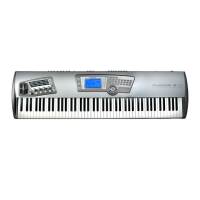6
PERFORMANCE PANEL VIEW
The Fusion’s Performance Panel is what you’ll often reach for during a performance. The
wheels, knobs, and buttons will allow you to tweak things like pitch, modulation, or filter cutoff
while you’re playing. This chapter will explain the basics—for more in depth coverage see the
reference manual.
The Performance Panel’s components consist of the following:
1. PITCH BEND WHEEL: This is a standard pitch bend wheel that behaves just like on any other
synthesizer. Use this to create expressive pitch changes during a performance.
2. MODULATION WHEEL: The modulation wheel (or “mod wheel” for short) can be assigned to
control many parameters within the keyboard like vibrato, tremolo, FM amount, etc. Like the
pitch wheel, it’s often used to add expressivity to your performance. The mod wheel is usually
mapped to vibrato as a default, but it is possible to map it to almost anything using the Fusion’s
Modulation Matrix. See the reference manual to find out how to do this.
3. PERFORMANCE GRID: The Performance Grid tells you what your Control Knobs are
currently assigned to. There are four rows and the active row is illuminated while other rows
remain dimmed. Use the ARP, FILTER, EQ, and ASSIGN buttons (see below) to select your
active row.
4. ARP, FILTER, EQ, ASSIGN: These buttons select the active row on the performance panel.
ARP, FILTER, and EQ are hard-wired to arpeggiator, filter, and EQ functions whereas the
assign row lets you map the Control Knobs to any parameter of your choosing.
1
2
3
4
5
7
8

